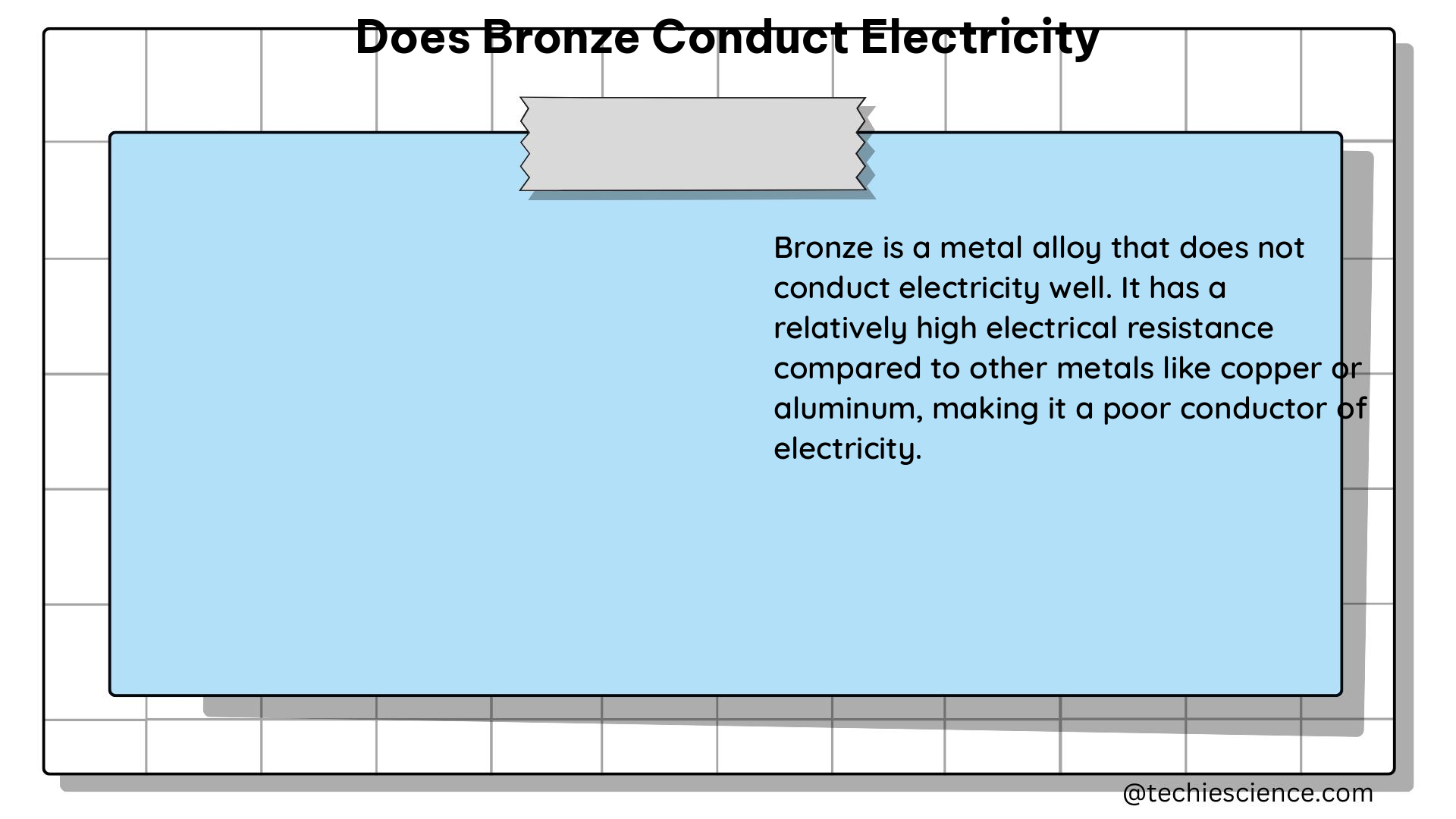Bronze, an alloy primarily composed of copper and tin, does conduct electricity, but not as efficiently as some other metals like copper, silver, and gold. The electrical conductivity of a material is determined by the number of free electrons available to carry an electric current. In pure metals like copper, there are many free electrons, making them excellent conductors of electricity. However, in alloys like bronze, the addition of other elements like tin can reduce the number of free electrons, thereby decreasing its electrical conductivity.
Understanding Electrical Conductivity
Electrical conductivity is a measure of a material’s ability to allow the flow of electric current. It is typically expressed in Siemens per meter (S/m), which represents the number of electrons that can move freely through the material. The higher the electrical conductivity, the better the material can conduct electricity.
The electrical conductivity of a material is directly related to the number of free electrons available in its atomic structure. In pure metals, the atoms are arranged in a way that allows the electrons to move freely, resulting in high electrical conductivity. However, in alloys like bronze, the addition of other elements can disrupt the arrangement of the atoms, reducing the number of free electrons and, consequently, the electrical conductivity.
Comparing Electrical Conductivity of Bronze and Copper

To quantify the electrical conductivity of bronze, we can compare it to that of copper, which is considered one of the best electrical conductors among common metals.
The electrical conductivity of copper is approximately 59.6 × 10^6 S/m, while the electrical conductivity of bronze is around 9 × 10^6 S/m. This means that the electrical conductivity of bronze is approximately 15% that of copper, or in other words, copper is about six times more conductive than bronze.
The reason for this difference in electrical conductivity is the presence of tin in the bronze alloy. Tin has a lower electrical conductivity than copper, and its addition to the alloy reduces the overall number of free electrons available for electrical conduction.
Thermal Conductivity of Bronze
In addition to electrical conductivity, the thermal conductivity of a material is also an important factor to consider. Thermal conductivity is a measure of a material’s ability to conduct heat.
The thermal conductivity of bronze is lower than that of copper, which is one of the reasons why bronze is a poor conductor of heat compared to copper. The thermal conductivity of bronze is approximately 35 W/(m·K), while the thermal conductivity of copper is around 400 W/(m·K).
The lower thermal conductivity of bronze is also related to the presence of tin in the alloy. Tin has a lower thermal conductivity than copper, and its addition to the alloy reduces the overall thermal conductivity of the material.
Factors Affecting Electrical and Thermal Conductivity of Bronze
The electrical and thermal conductivity of bronze can be influenced by several factors, including:
-
Composition: The ratio of copper to tin in the bronze alloy can affect its conductivity. Increasing the copper content can improve both electrical and thermal conductivity.
-
Impurities: The presence of impurities in the bronze alloy can also impact its conductivity. Impurities can disrupt the arrangement of the atoms, reducing the number of free electrons and decreasing the overall conductivity.
-
Microstructure: The microstructure of the bronze, such as the grain size and distribution of the copper and tin phases, can influence its conductivity. A more homogeneous microstructure can improve the material’s conductivity.
-
Temperature: The electrical and thermal conductivity of bronze can vary with temperature. Generally, as the temperature increases, the conductivity of bronze decreases due to increased scattering of the charge carriers (electrons) and phonons (heat carriers).
Practical Applications of Bronze’s Conductivity
Despite its lower electrical and thermal conductivity compared to copper, bronze still finds various applications where its unique properties are advantageous:
-
Electrical Contacts: Bronze is used in electrical contacts, such as in switches and relays, due to its resistance to corrosion and wear.
-
Decorative Applications: The lower thermal conductivity of bronze makes it suitable for decorative applications, such as in sculptures and architectural elements, where it can be used to create intricate designs without the risk of overheating.
-
Musical Instruments: Bronze is commonly used in the construction of musical instruments, such as bells and cymbals, due to its unique acoustic properties.
-
Plumbing and Piping: Bronze is used in plumbing and piping applications, particularly in areas with corrosive environments, due to its resistance to corrosion.
Conclusion
In summary, while bronze does conduct electricity, its electrical conductivity is lower than that of some other metals, such as copper, silver, and gold. This is primarily due to the presence of tin in the bronze alloy, which reduces the number of free electrons available for electrical conduction. Additionally, the thermal conductivity of bronze is also lower than that of copper, making it a poor conductor of heat compared to copper.
Understanding the electrical and thermal conductivity of bronze is crucial in various applications, where its unique properties can be leveraged to achieve specific design and performance requirements.
Reference:
- Properties of Bronzes
- What Is Electrical Conductivity (EC)?
- ELI5: Why is bronze such a poor conductor of heat and electricity compared to other metals?
Hi..I am Indrani Banerjee. I completed my bachelor’s degree in mechanical engineering. I am an enthusiastic person and I am a person who is positive about every aspect of life. I like to read Books and listen to music.